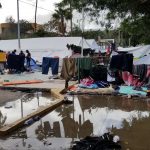I’m no stranger to rough situations. From 2015 to 2017, I monitored an international border in a conflict zone, wearing protective gear and driving an armored vehicle. I tallied civilian casualties, measured shelling craters, documented landmines and anti-tank mines, and advocated for concrete measures to improve protection for civilian populations. Managing the sometimes competing demands of hard security with that of human rights protection was the order of the day. And navigating a geographic area with serious security issues and active armed conflict became second nature. But my recent trip to the U.S.-Mexico border, as part of a Physicians for Human Rights team, made me rethink the notion of security and the delicate balance between protection and intimidation.
My job involves partnering with doctors and other clinicians; our goal is to provide asylum seekers with forensic evaluations that present clinical evidence supporting their asylum claims. Our work enables us to get up close and personal with asylum seekers, and to attempt to stand in their shoes, if only for a few hours. As I looked around me in Tijuana at the thousands of men, women, and children huddled in makeshift tents with completely inadequate sanitation, drainage, or garbage collection – many sniffling with colds or flu – I struggled to make sense of what was clearly a disproportionate security response to this growing humanitarian crisis. Squads of Mexican riot police in full gear with shields stood guard outside the Benito Juarez sports stadium where some 6,000 migrants were sheltering, and armed U.S. border patrol agents in flak jackets took up positions at the border crossing just a few miles away. Helicopters hovered loudly above our heads most of the day, flying low, in what became apparent was an intimidation tactic. After a day of heavy rainfall, as far as the eye could see, everything was drenched. Blankets, sleeping mats, and tents were soaked and muddied, and migrants hung their wet clothes on walls and fences, in the hope that they might dry in the elusive sun. The scene was that of desperation – not some fearsome mob in need of containment. Yet, the helicopters continued to fly overhead and busloads of riot police remained on standby.
It had been less than a week since tear gas had been deployed on a group of migrants near the border. I met two mothers with young children who were among those caught up in the chaotic incident. They told me how scared they had been – especially the children. It was yet another example of the disproportionate use of force at the border – a natural consequence of the United States investing in hard security measures instead of in an immigration system that protects basic human rights. Under these conditions, it’s almost inevitable that more incidents of violence will take place. With severe restrictions over who can approach the border and where, thousands of asylum seekers just wait indefinitely in Tijuana with little understanding of what options are available to them. The absence of a sense of fairness at the border and the lack of human rights protections have resulted in migrants taking the process into their own hands – for better or worse. There is a handwritten list at the Chaparral crossing which migrants have organized on their own in a bid to create some semblance of order during their seemingly endless wait. Some clutched small pieces of paper bearing their number – most with digits in the thousands, denoting weeks, if not months, of waiting. Some told me that they had been waiting for over a month just to have a chance to present their case, let alone cross the border. Mothers with children slept on sidewalks, sometimes facing threats to their safety, awaiting their turn.
We know from our work that an efficient and humane asylum system should ensure that asylum seekers’ rights are exercised within a reasonable length of time and that conditions at ports of entry for those who are waiting should be safe and humane. But if U.S. Customs and Border Protection don’t take immediate steps to improve, expand, and strengthen asylum processing staffing and infrastructure to address the current backlog and to prevent future backlogs, we’re unlikely to see the morass at the border change.
But perhaps most importantly, the U.S. government must recognize this situation for the humanitarian crisis that it is. Migrants from El Salvador, Guatemala, and Honduras, many of whom joined the recent migrant caravan, are fleeing real dangers in their home countries. Most are aware that if they are among the so-called “lucky ones” to enter the United States, they will likely face detention and possible family separation. Despite this, they still want to cross the border. For if they return home, they say, the dangers are far greater.
These people have a legitimate need for international protection – and the U.S. has a legal obligation – not to mention a moral one – to allow them to seek it. For now, though, they wait and they pray for their number to be called. As for what happens next, one woman told us, “Only God knows.”

